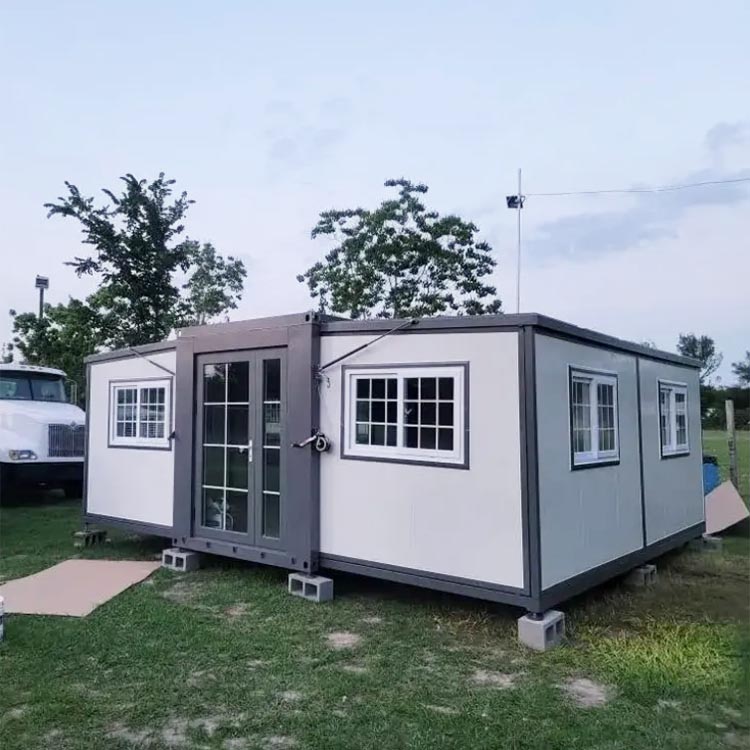How Do Expandable Containers Redefine Space and Mobility?
2025-09-25
In today’s fast-paced world, businesses, organizations, and individuals are constantly seeking space solutions that are flexible, portable, and cost-effective. The expandable container has emerged as one of the most innovative answers to this growing demand. Unlike traditional shipping containers, which offer limited adaptability, expandable containers are designed to unfold or expand, creating larger usable areas within minutes. This unique feature not only increases capacity but also enhances the container’s functionality in multiple industries such as construction, hospitality, emergency relief, healthcare, retail, and remote living.
So, what makes an expandable container so transformative? It is the combination of mobility and versatility. A standard container might only serve as storage or transport space, but an expandable model can function as a mobile office, living quarters, classroom, clinic, or even a pop-up store. This adaptability has reshaped how governments, corporations, and entrepreneurs think about portable infrastructure.
From a structural standpoint, expandable containers are built with robust steel frames, weather-resistant panels, and ergonomic folding systems that allow rapid setup and dismantling. Most importantly, they adhere to international safety and building standards, making them suitable for both temporary and semi-permanent deployment.
How Do Expandable Containers Work and What Features Define Their Performance?
The mechanism of an expandable container is straightforward yet highly engineered. At first glance, it resembles a conventional shipping container. However, once positioned on site, the side panels, walls, and roof sections are designed to unfold and slide into place, often doubling or tripling the original floor area. Some models can be set up in under 30 minutes, making them a favorite choice for rapid deployment scenarios such as construction sites, disaster relief shelters, or mobile event spaces.
Key Features of Expandable Containers:
-
Quick Deployment: Expandable containers can be set up without heavy machinery, reducing labor costs.
-
Spacious Design: Floor area can be doubled by expanding the side modules.
-
Durability: Built from galvanized steel frames and insulated wall panels.
-
Mobility: Easily transported using standard logistics methods.
-
Energy-Efficient Options: Equipped with insulation and optional solar panels for sustainable use.
-
Customizable Layouts: Configurations can be adapted for offices, dormitories, clinics, or retail outlets.
-
Security: Reinforced locking systems protect contents and occupants.
To give a professional overview, below is a detailed parameter table of a typical expandable container:
| Parameter | Specification |
|---|---|
| External Dimensions | 5800mm (L) × 2200mm (W) × 2500mm (H) (before expansion) |
| Expanded Dimensions | 5800mm (L) × 6300mm (W) × 2500mm (H) |
| Frame Material | High-strength galvanized steel |
| Wall Panels | 50mm–75mm EPS/rock wool sandwich panels |
| Flooring | Plywood with vinyl/PVC finish |
| Doors & Windows | Aluminum alloy with tempered glass |
| Electrical System | Pre-installed wiring, LED lighting, sockets, switchboards |
| Plumbing | Optional kitchen and bathroom integration |
| Insulation Performance | Thermal conductivity ≤ 0.038W/m·k |
| Fire Resistance | Grade A1/A2 compliant |
| Assembly Time | 20–40 minutes depending on model |
| Lifespan | 15–20 years with proper maintenance |
These technical details show why expandable containers are far more than temporary units. They are robust, versatile structures engineered for efficiency and long-term usability.
Why Should Businesses and Communities Choose Expandable Containers?
The question of why expandable containers are being adopted across so many industries comes down to three main factors: cost-efficiency, adaptability, and sustainability.
1. Cost-Efficiency
Traditional buildings demand high upfront investments, require permits, and often involve delays. In contrast, expandable containers can be delivered, assembled, and used almost immediately. This reduces both capital and operational expenditures, making them attractive for start-ups, NGOs, and government projects with tight budgets.
2. Adaptability
Expandable containers can serve as housing units, healthcare clinics, classrooms, offices, or exhibition halls. For construction companies, they provide mobile headquarters. For educational institutions, they solve classroom shortages in rural or urban areas. For healthcare organizations, they can be deployed as vaccination centers, mobile labs, or emergency treatment units. This level of adaptability makes them an essential tool in modern infrastructure planning.
3. Sustainability
Sustainability is not a trend but a necessity. Expandable containers often integrate eco-friendly technologies such as solar power systems, LED lighting, and water-saving plumbing. Their reusability means they generate less construction waste compared to traditional methods. For governments seeking to meet environmental goals, or corporations aiming for greener footprints, expandable containers are an attractive solution.
Real-World Applications:
-
Construction Sites: Temporary offices, staff accommodations, or storage facilities.
-
Healthcare: Mobile clinics, testing stations, and emergency wards.
-
Education: Rapid classroom deployment in underdeveloped regions.
-
Retail: Pop-up shops, showrooms, and mobile food outlets.
-
Events & Tourism: Portable lodges, ticket booths, and exhibition spaces.
-
Emergency Relief: Disaster shelters, refugee housing, or command centers.
This broad scope of applications demonstrates the transformative impact expandable containers bring to both developed and developing regions worldwide.
What Does the Future Hold for Expandable Containers and How to Get Started?
The future of expandable containers is strongly tied to global trends in urbanization, disaster preparedness, and modular construction. As populations grow and space becomes scarcer, demand for quick, mobile, and affordable structures will only rise. Governments and businesses are increasingly turning to modular, relocatable solutions, and expandable containers are leading the way.
We can expect further innovation in the coming years, including:
-
Integration of Smart Technologies: Remote monitoring, smart locks, and IoT-enabled utilities.
-
Eco-Friendly Materials: Use of recyclable steel, sustainable insulation, and renewable energy systems.
-
Luxury Customization: Expansion into hospitality and high-end housing sectors.
-
Mass Adoption in Urban Areas: As real estate costs rise, expandable containers will provide affordable housing and office alternatives.
If you are considering adopting expandable containers for your project, it is important to collaborate with a trusted supplier who ensures quality, safety, and international compliance.
Frequently Asked Questions (FAQs)
Q1: How long does it take to install an expandable container?
Most models can be deployed in 20–40 minutes with a small team, making them one of the fastest infrastructure solutions available.
Q2: Can expandable containers be customized for specific needs?
Yes, they can be configured with kitchens, bathrooms, air conditioning, solar panels, and furniture to meet a wide range of requirements.
Q3: Are expandable containers safe for long-term use?
Absolutely. Built with galvanized steel and insulated panels, they comply with fire safety and structural durability standards, offering a lifespan of up to 20 years.
In conclusion, expandable containers represent a breakthrough in mobile infrastructure, offering a balance between efficiency, durability, and sustainability. They are not only redefining temporary spaces but are also influencing how businesses and governments approach long-term infrastructure challenges.
As one of the reputable names in this sector, Yilong has established itself as a reliable provider of expandable container solutions, ensuring quality, safety, and customization for clients worldwide. If you are ready to explore how expandable containers can transform your project, contact us today to learn more and start building a smarter, more flexible future.



